
Chris Brown was determined to travel to the world most remote places. (Simika Best via SWNS)
By Doug Shields
A British explorer has made history by becoming the first person to reach seven of the planet’s most inaccessible places.
Chris Brown, 63, is on a mission to visit all eight Poles of Inaccessibility (PIAs) - the exact spot on a continental land mass or ocean that is furthest from the sea or coast in any direction.
He has already ticked off six of them in North America, South America, Africa, Australia, the Antarctic, and the oceanic pole at Point Nemo in the middle of the Pacific Ocean.
Now he has notched up his seventh after reaching the Northern Pole of Inaccessibility (also known as the Arctic PIA), which is around 400 miles from the geographic North Pole.
He is the first person in history to reach seven PIAs and now has only one remaining - the Eurasian pole in north west China.
Chris, a tech entrepreneur of Harrogate, North Yorks., had failed in an earlier attempt to reach the Northern Pole in 2019 due to developing geopolitical factors and bad weather.

(Chris Brown via SWNS)
The father-of-two said: “This one feels like it has been a long time coming.
“When I set myself the target of visiting all the poles of inaccessibility, I thought maybe three or four would be achievable. But here we are!
“Never give up. Just never give up. No matter how hard your dreams may seem, keep working and see what happens.
“The Arctic may be warmer than the Antarctic, but the shifting ice flows and currents make this PIA almost as difficult to achieve.”
The Northern PIA lies at 85°48′N, 176°09′E. Countless explorers have tried and failed to reach it because of its remoteness, moving ice and extreme cold.
Sir Wally Herbert came close to being the first to the pole in 1968 by dog sled but failed due to ice pack movements.
Then a Russian expedition including Dmitry Shparo said they skied through the pole one Arctic night, but offered no other proof.
In 2005, explorer Jim McNeill asked scientists at the National Snow and Ice Data Center and the Scott Polar Research Institute to update the position of the pole using modern GPS and satellite data.
The revised location co-ordinates of Latitude: 85°48' N, Longitude: 176°9' E - which is 1008 km/626 miles from land - were published in Polar Record in 2013.

Chris Brown during his travels. (Simika Best via SWNS)
McNeill set out the following year (2006) to be the first to reach it while also gathering sea-ice data for NASA, but the expedition was forced to turn back.
He tried again in 2010 with his Ice Warrior team, only to be beaten once more by the poor state of the drifting ice.
Other explorers, such as the Norwegian Børge Ousland, have also approached the area, but the shifting ice and logistical challenges have ensured that the Northern Pole of Inaccessibility remained one of the least-visited and most elusive points on Earth.
Indeed, it was not until 2020 that Swedish adventurer Frederik Paulsen became the first person to reach the Northern PIA while on his record-breaking mission to reach all eight of the world's poles (geographic, geomagnetic, magnetic, and least accessible in both the north and southern hemispheres).
Chris himself was foiled in 2019 after the Ukranian Antonov An-74 aircraft he was due to use was grounded due to tensions with Russia.
This time round he boarded the ice breaker 'Le Commandant Charcot' on September 5 and managed to persuade the skipper to make a detour so he was able to get within 1km of the PIA coordinates.

(Chris Brown via SWNS)
From there, he walked across the ice with a team of three to reach their destination on the morning of September 18.
On the way the ship also visited the geographic North Pole, where Chris went hiking on the ice, cross-ice skiing, snowshoeing, kayaking and the diving world record holder even managed an Arctic Plunge - diving into the icy water at with a temperature of -2.
The closest coasts to the location are Henrietta Island in the East Siberian Sea, Cape Arctic on Severnaya Zemlya, and Ellesmere Island in the Canadian Arctic.
On the way Chris was lucky enough to see Arctic Foxes and several large walrus colonies as well as humpback whales.
He also spotted three polar bears - a lone female and another female with a grown-up cub.
At The Northern Pole of Inaccessibility there is only 30 minutes of sunlight every day.
Chris added: “I’d like to thank Captain Patrick Marchesseau for his support in reaching this Arctic Pole of Inaccessibility and his skill in navigating Arctic waters.
“I’d also like to thank Sigurdur Sveinsson and Simika Best for bringing this vessel’s capabilities to my attention and support in my adventures.”
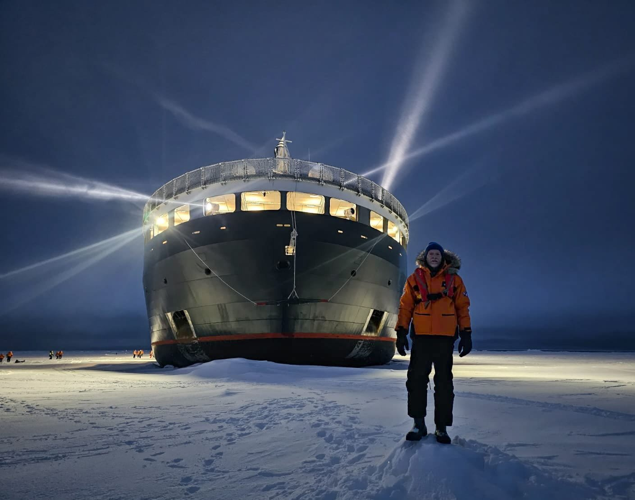
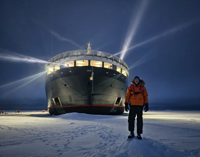

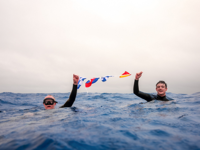

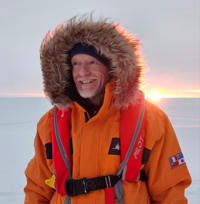

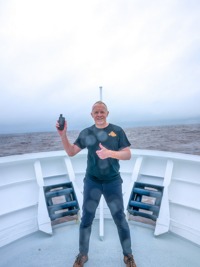













(0) comments
Welcome to the discussion.
Log In
Keep it Clean. Please avoid obscene, vulgar, lewd, racist or sexually-oriented language.
PLEASE TURN OFF YOUR CAPS LOCK.
Don't Threaten. Threats of harming another person will not be tolerated.
Be Truthful. Don't knowingly lie about anyone or anything.
Be Nice. No racism, sexism or any sort of -ism that is degrading to another person.
Be Proactive. Use the 'Report' link on each comment to let us know of abusive posts.
Share with Us. We'd love to hear eyewitness accounts, the history behind an article.